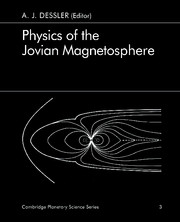Book contents
- Frontmatter
- Contents
- List of tables
- List of contributors
- Foreword
- Preface
- 1 Jupiter's magnetic field and magnetosphere
- 2 Ionosphere
- 3 The low-energy plasma in the Jovian magnetosphere
- 4 Low-energy particle population
- 5 High-energy particles
- 6 Spectrophotometric studies of the Io torus
- 7 Phenomenology of magnetospheric radio emissions
- 8 Plasma waves in the Jovian magnetosphere
- 9 Theories of radio emissions and plasma waves
- 10 Magnetospheric models
- 11 Plasma distribution and flow
- 12 Microscopic plasma processes in the Jovian magnetosphere
- Appendix A Symbols and acronyms
- Appendix B Coordinate systems
- Appendix C Jupiter and Io: selected physical parameters
- References
- Index
12 - Microscopic plasma processes in the Jovian magnetosphere
Published online by Cambridge University Press: 27 October 2009
- Frontmatter
- Contents
- List of tables
- List of contributors
- Foreword
- Preface
- 1 Jupiter's magnetic field and magnetosphere
- 2 Ionosphere
- 3 The low-energy plasma in the Jovian magnetosphere
- 4 Low-energy particle population
- 5 High-energy particles
- 6 Spectrophotometric studies of the Io torus
- 7 Phenomenology of magnetospheric radio emissions
- 8 Plasma waves in the Jovian magnetosphere
- 9 Theories of radio emissions and plasma waves
- 10 Magnetospheric models
- 11 Plasma distribution and flow
- 12 Microscopic plasma processes in the Jovian magnetosphere
- Appendix A Symbols and acronyms
- Appendix B Coordinate systems
- Appendix C Jupiter and Io: selected physical parameters
- References
- Index
Summary
Plasma waves observed near Jupiter exhibit characteristics similar to waves in the terrestrial magnetosphere and a quantitative analysis suggests a universality of the generation mechanisms. Electromagnetic whistler-mode waves are enhanced within the high-density plasma torus surrounding the orbit of Io and evidence for electron stable trapping is found in the inner torus. The observed intensity of low-frequency hiss is sufficient to scatter resonant (≳ 100 keV) electrons and cause continuous precipitation loss to the atmosphere at a rate comparable to 5% of the limit imposed by strong pitch-angle diffusion. The energy flux into the Jovian atmosphere is estimated to be approximately 3 mW/m2 over a broad invariant latitude range 65° ≲ Λ ≳ 70° mapping from the Io torus. Total power dissipation may therefore approach 1013 W. But because the energetic electron deposition occurs deep in the Jovian atmosphere, little of the concomitant auroral emission should be detectable by Voyager. The intermittent bursts of electromagnetic chorus and the equatorially confined electrostatic (n + 1/2)fc,e waves can at times scatter lower energy (keV) electrons on strong diffusion. The net energy deposition, however, is typically less than 0.5 mW/m2 and the total power dissipation over the entire auroral zone should be ≲ 1012 W. Energetic ions exhibit evidence for rapid precipitation loss throughout the plasma torus. Although the waves responsible for such scattering have not yet been identified, ion precipitation loss near the strong diffusion limit apparently offers the only viable mechanism to excite the observed auroral emissions.
- Type
- Chapter
- Information
- Physics of the Jovian Magnetosphere , pp. 454 - 488Publisher: Cambridge University PressPrint publication year: 1983
- 70
- Cited by



